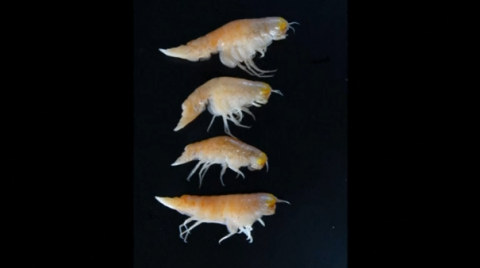
Reuters — A study of the Pacific Ocean’s Mariana and Kermadec trenches has found man-made pollutants in the deepest parts of the Pacific Ocean.
Small crustaceans called amphipods, which populate the deepest recesses of the Pacific, were found to contain disturbingly large levels of Persistent Organic Pollutants (POPs) in the organism’s fatty tissue.
Voracious eaters who will eat anything that comes their way, amphipods are ideal for such research.
Amphipod samples brought to the surface contained chemicals called polychlorinated biphenyls (PCBs) and polybrominated diphenyl ethers (PBDEs), commonly used as electrical insulators and flame retardants. Use of the former was banned in the 1970s.
“They (PCBs) don’t exist in nature, which makes them an ideal tracer to look for in more and more environments because if you’re looking for a footprint of human activity things like PCBs are an ideal thing to look for because they have to have come from industrial activity,” said lead researcher Dr Alan Jamieson.
Deep sea landers designed by Jamieson, senior lecturer in marine ecology at Newcastle University, were used to plumb the depths of the Pacific Ocean and bring amphipods from more than 10 kilometres underwater to the surface.
“We lower the lander into the sea from a vessel and we just let it go,” explained Jamieson. “On the vehicle itself there are cameras, pressure sensors, temperature sensors, water samplers and traps. It freefalls straight down to the sea floor, so at a full ocean depth of 11 kilometres, it would take about four hours in freefall to reach the bottom and it crash lands, and we bait it with fish we find in that area so we don’t contaminate, and we basically film what comes to it.”
Jamieson was shocked at the levels of pollution found inside the stomachs of amphipods brought back to the surface.
He told Reuters: “The biggest surprise was that the Mariana Trench samples were so high. They were huge, they were just unbelievable – although comparisons are quite difficult sometimes because it depends on how the animal metabolises its food and things like that. The levels were, at face value, 50 times higher than what’s considered to be one of the most polluted rivers in China.”
The authors believe the pollutants were probably transported to the trenches through contaminated plastic debris and dead animals sinking to the bottom of the ocean. These are often consumed by amphipods and other fauna, which are then eaten by larger fauna, beginning their journey up the food chain.
Initially released into the environment through industrial accidents, discharges, and landfill leakages, the pollutants will not degrade naturally.
“The significance for us is the legacy of human activity,” said Jamieson. “There’s this idea that very deep, very remote, environments are safe, they’re pristine, they’re out of sight, out of mind, but here we are and you can find man-made contaminants inside the stomachs of an amphipod that’s probably only two or three years old. That, I think, is quite frightening in terms of legacy.”
The trenches in the north west Pacific are close to areas of high industrialisation, such as China, Taiwan, and Japan.
Researchers from Newcastle University, the University of Aberdeen, and the James Hutton Institute published their findings in Nature Ecology & Evolution. Jamieson is continuing his examination into the findings, with the aim of better understanding how such pollution might affect the wider ecosystem.







